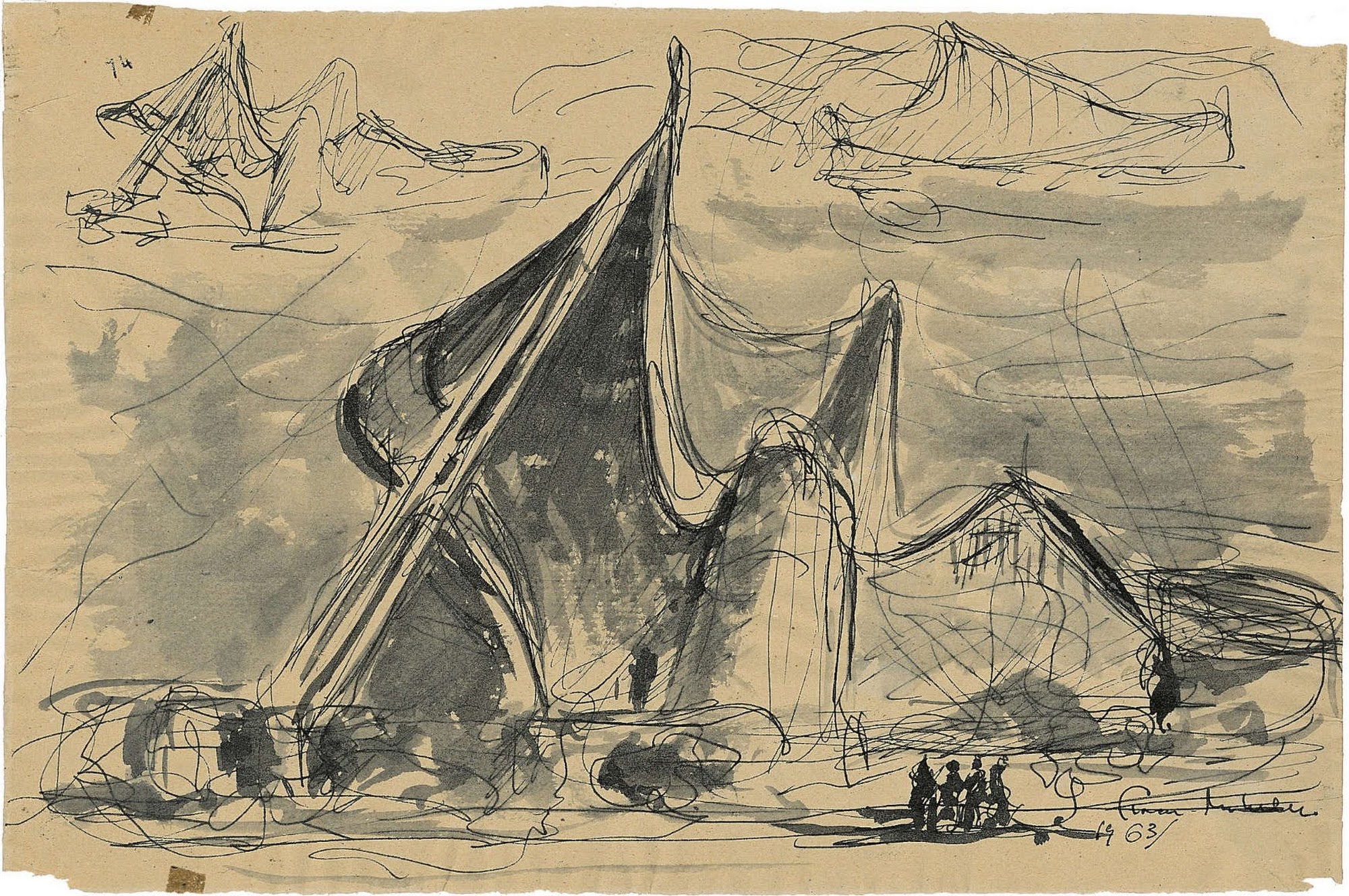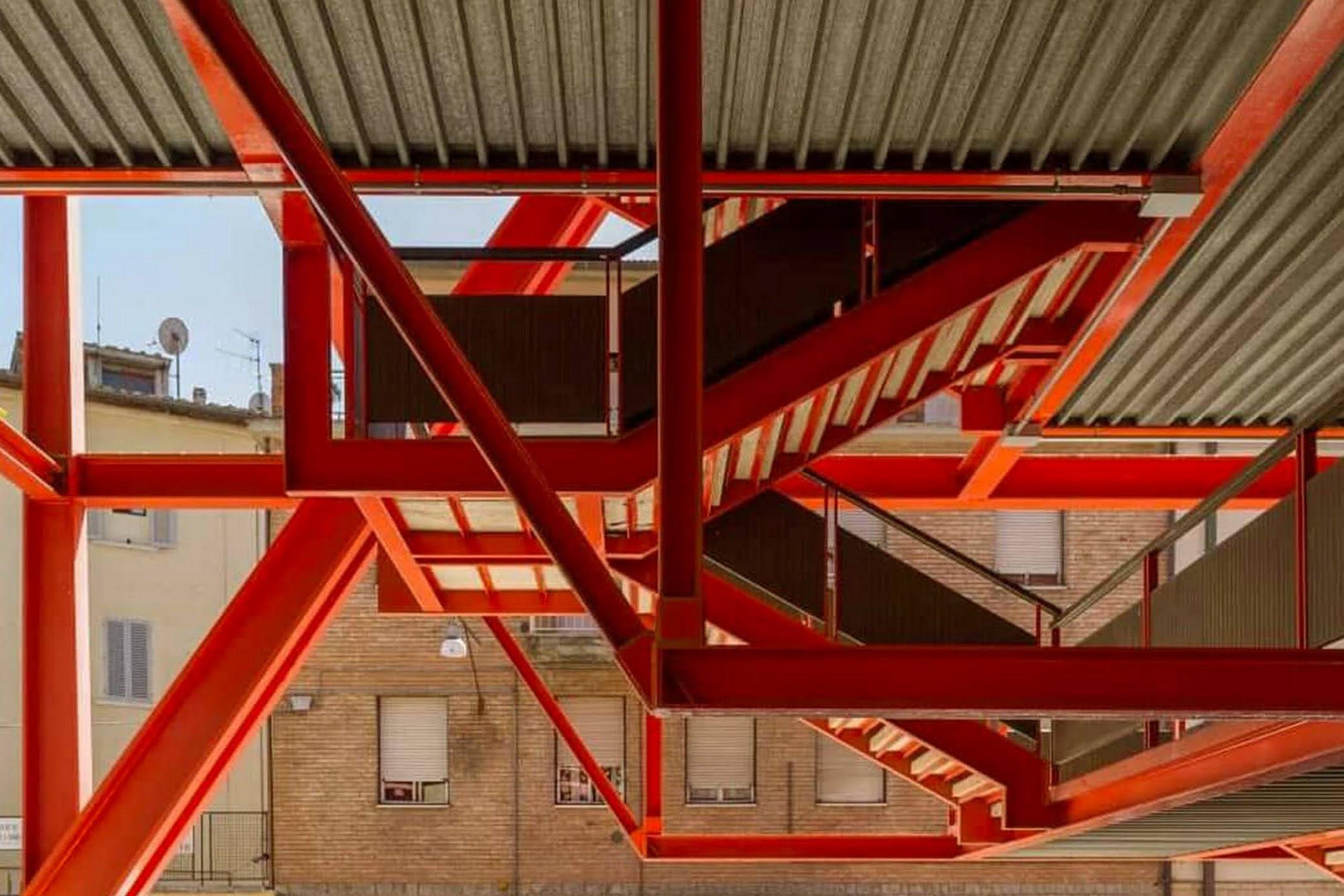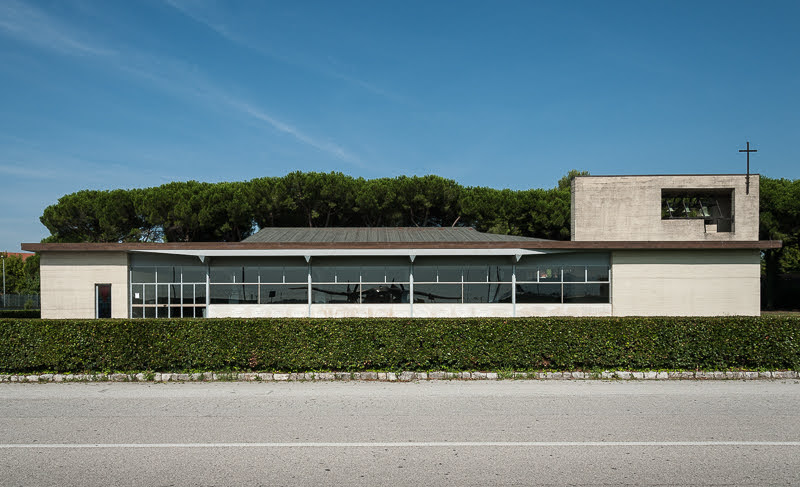| |
|
 |
 |

|
| N L |
Giovanni Michelucci, Chiesa di San Giovanni Battista o Chiesa dell'Autostrada del Sole [1960-64] [2]
|
|
![Toacana ] Galleria di immagini](/titels/albump.gif) |
|
| |
 |
|
|
| |
|
Giovanni Michelucci, Chiesa di San Giovanni Battista or the Chiesa dell'Autostrada del Sole [1960-64]
|
|
|
|
| |
|
| |
|
«This church is a little town,
A tuned up space where men, as they meet, should,
So long as the language of the architecture has been efficient,
See themselves in a common interest and hope,
Which is ‘finding their own self’». |
| |
|
Giovanni Michelucci, 1964
|
Giovanni Michelucci (Pistoia, 2 January 1891 - Firenze, 31 December 1990) was an Italian architect and urban planner. He was one of the most important Italian architects of the 20th century, famous for, among other things, designing the Stazione Santa Maria Novella and the Autostrada del Sole church.
The chiesa di San Giovanni Battista in the comune Campi Bisenzio, on the outskirts of Florence, has also earned the name Church of the Freeway of the Sun for its location between autostrada del Sole and the A11 Firenze-Mare.
Chiesa di San Giovanni Battista or The Church of the Freeway of the Sun,[ 1960-64]
The design of the church is meant to reflect both modern and traditional church design. The "cross" floor plan and stone facing are meant to evoke a traditional feel, while the tent-like vertical elements and copper roofing reflect modern design tastes. The church stands 27.5 meters (90 feet) high.
It was built between 1960 and 1963, based on plans by Giovanni Michelucci. The materials used for the building are local natural stone and concrete for the walls; copper for the roof, oxidized to green on the outside; and burnished blond on the inside. Marble, glass, and bronze are used for the interior elements. The floorplan of the building is asymmetrical and follows sinuous curves creating a feeling of fluid space. The church is decorated with works of Marcello Avenali, Jorio Vivarelli, Dilvo Lotti, and Luigi Venturini.
|
|
Suggestieve beelden van de Chiesa dell'Autostrada del Sole [1960-64] [2]
|
The intention of the church builders was to honor the workers who had died during construction of the freeway. The highway Autostrada del Sole came at the price of 164 lives of construction workers. The Chiesa dell’Autostrada was inspired as a tribute to these lost lives[4].
The Autostrada del Sole is a reflection of two great societal changes of the 1960s, a society moving toward a more mobile and itinerant culture and the new religious ideas brought forward in the Second Vatican Council pronouncements. Michelucci himself saw the church as a metaphor for the meeting of different cultures and wanted the architecture to echo the way people met and interacted in the streets [4].
Francesco Dal Co:
«The church of San Giovanni Battista all'Autostrada del Sole (196o-64), seen from the plain surrounding Florence, also appears as a huge tent stretched over a mountain valley
To explain the meaning of this, his most famous work, Michelucci recalls, citing a letter by Saint Paul, how the life of man on Earth is similar to that which takes place under a tent: the whole world is a precarious shelter that hosts the hope of our final home in heaven. This motif animates the construction of San Giovanni Battista. The contrast between the tensile roof and the stone base of the enclosure is marked. With its extreme plasticity, the vast tent spans from volume to volume, covering the complex labyrinth of the interior, where circulation and level changes multiply and space flows among the branches of reinforced concrete pilasters that find their way to the ground in myriad ways. Under the light, the curved stone walls and the folded skeleton of the concrete structure acquire emotionally expressionistic accents and a vibrant dynamism. A sort of underground city, petrified in its own contortions, is represented under the vast cover, which is tied to the ground by an elegant connector as if to save it from the dangerous effects of the wind» [5].
|
 |
Giovanni Michelucci, immaghini suggestivi Chiesa di San Giovanni Battista o Chiesa dell'Autostrada del Sole (interno), Campi Bisenzio, Firenze [2]
|
The fundamental role of drawing in Giovanni Michelucci's work
Michelucci's sketch plan was ready in the spring of 1961: at this stage, some points were already fully defined (the relationship between the stone wall structure and the copper roofing, the connection between the baptistery and the narthex, the bell tower and the horizontally developed railings), while others still needed further study, such as the buttresses and the roof structure.
Michelucci draws with the spirit of freedom that animated Tuscan architecture from medieval civilisation onwards.
|
 |
Giovanni Michelucci, La Chiesa dell'Autostrada, Firenze. Vedute prospettiche della tenda, 1963
Penna, pennello e inchiostro su carta (© Fondazione Giovanni Michelucci, Fiesole)
|
Images from the Archivio Fondazione Michelucci highlight the fundamental role of drawing in Michelucci's work. The drawings reveal his inexhaustible capacity for research, ranging from tiny architectural details to large-scale urban development and landscape design. When he draws, Michelucci strives not for technical precision, but for the expressionist evocation of forms and movement. For him, the architectural project lies between the life of the building site and the vitality of free drawing, which evokes future spaces[7] [3]. Sometimes he continues to draw a project even after its completion and explore new possibilities, as in the case of the Chiesa dell'Autostrada del Sole.
|
 |
| La Chiesa dell'Autostrada come elemento della città attraversato e penetrato da percorsi urbani - Penna e china su carta, 50 cm x 70 cm, 1969 Archivio Giovanni Michelucci
|
The temple of San Giovanni Battista is Michelucci's strongest expression of his refusal to use established typological configurations for his churches. Typology defines a use, codifies a function, embalms practices and values. Michelucci confronts all of this with the fluidity of his underground spaces, which are recomposed only by the vast sail of the cover, leaving the "use" unprescribed. In fact, the churches of Michelucci are places of free human assembly, as demonstrated by his designs for the Santuario della Beata Vergine in San Marino (I961-67) and the church of the Immacolata Concezione di Maria Vergine in Longarone (1966-78), which repeat the Florentine experience[5].
|
| |
|
|
|
|
|
|
Sketches for the churches Chiesa dell'Autostrada del Sole [1960-64], Santuario della Beata Vergine in San Marino [I961-67], and the Immacolata Concezione di Maria Vergine in Longarone [1966-78] [8]
|
The Chiesa dell'Autostrada del Sole is located in the territory of the comune Campi Bisenzio, at the Firenze Nord service area of the Autostrada del Sole A1 Rome-Milan.
Michelucci tried to estblish a connection with the landscape. For the external walls of the church, he resolutely chooses stone from the surrounding hills, and so the church seemded to be an integral part of the Tuscan landscape.
The relationship of Michelangelo's architecture to its surroundings has changed dramatically since the 1960s. Although some elements of the surroundings remained unchanged - the plain with the surrounding hills, the motorway, there are also numerous new infrastructures, from the runway of the Amerigo Vespucci airport with all its associated facilities, to the neighbouring motorway administration building (Direzione Generale Autostrade per l'Italia) and the nearby shopping area of Osmannoro.
As a result, the rural character, which had played such an important role in the church's design, gradually has faded away.
|
|
|
|
| |
|
|
Map Chiesa di San Giovanni Battista (Chiesa dell'Autostrada del Sol) [1960-64],
Campi Bisenzio - autostrada A1 uscita Firenze Nord | Enlarge map
San Giovanni Battista or dell'Autostrada del Sole is a church in Campi Bisenzio, near Florence, Italy, within a large motorway rest area shared between two autostrada roads. It can also be reached on foot from a local road outside the autostrada system (Via di Limite).
|
Album Giovanni Michelucci
|
 |
|
|
|
 |
Giovanni Michelucci, disegno Chiesa di San Giovanni Battista o 'dell'Autostrada', Campi Bisenzio (Firenze)
|
|
|
|
Giovanni Michelucci, Chiesa di San Giovanni Battista, Autostrada del Sole, Campi Bisenzio (Firenze), 1960-
1964, schizzo di studio, 1961
|
 |
|
 |
|
![Gino Barsotti (1900 – 1985), Chiesa di San Giovanni Battista 'dell’Autostrada', Campi Bisenzio, 1964, arch. G. Michelucci
[Fonte: Fondazione Giovanni Michelucci, Fiesole]](https://lh3.googleusercontent.com/414BLjVS47Ue7UZt0w7D_rZyx3EFXv6qbABpfzuY1N324lqxnhEcl0RBaSuv01S2JbJbr3vr2onOn0QelCPKpoWOKfU2v_HpcRUkLhlNx-J7D7bCNk6FimuH8izaHuUuXfrisdxQtjI=w700-h479-p-k) |
Giovanni Michelucci, Chiesa di San Giovanni Battista o Chiesa dell'Autostrada del Sole [ 1960-64]
|
|
Giovanni Michelucci, Chiesa di San Giovanni Battista o Chiesa dell'Autostrada del Sole (particolare) (Foto di Jacqueline Poggi)
|
|
Gino Barsotti (1900 – 1985), Chiesa di San Giovanni Battista 'dell’Autostrada', Campi Bisenzio, 1964, arch. G. Michelucci
|
 |
|
 |
|
 |
Palazzo del Monte dei Paschi di Siena (Colle Val d'Elsa), piazza pubblica del pian terreno, Giovanni Michelucci con Bruno Sacchi
|
|
Giovanni Michelucci (con Gruppo Toscano), stazione di Santa Maria Novella, Firenze
|
|
Giovanni Michelucci (con Gruppo Toscano), stazione Santa Maria Novella, Firenze (dettaglio del fronte principale)
|
 |
|
 |
|
 |
Giovanni Michelucci, Sacrario dei Caduti di Kindu (1961-62)
|
|
Giovanni Michelucci, La chiesa di Longarone (1976)
|
|
Giovanni Michelucci, La Limonaia di Villa Strozzi, il moderno teatro situato sul tetto (1973 -1998)
|
|
|
| |
|
| |
|
|
|
|
| |
|
|
|
|
| |


Traveling in Tuscany| Holiday homes in Colle di Val d'Elsa and southern Tuscany | Podere Santa Pia
|
|
|
|
|
 |
| Colline sotto Podere Santa Pia con ampia vista sulla Maremma Grossetana
|
| |
|
|
|
|
 |
Podere Santa Pia, situated in a particularly scenic valley, characterised by all the elements of the Tuscan landscape:
vineyards, pastures, small forests, wheat fields, olive groves and downey oaks.
|

[1] Photo by Traveling in Tuscany. All rights reserved © Traveling in Tuscany
[2] Foto di EC_Shots, (Elena Cocuccioni), licenziato in base ai termini della licenza Attribution-NonCommercial-NoDerivs 2.0 Generic (CC BY-NC-ND 2.0)
[3] Fonte: Archivio Giovanni Montelucci (Collezione Centro Documentazione Giovanni Michelucci di Pistoia, AD0766[1964].
1960-1964 | Chiesa di San Giovanni Battista o "dell'Autostrada", Campi Bisenzio (Firenze) (96 disegni)
1960-1964 | Chiesa di San Giovanni Battista o "dell'Autostrada", Campi Bisenzio (Firenze) (107 fotografie
[4] The Florentine School | Chiesa dell'Autostrada del Sole |
[5] Francesco Dal Co, Giovanni Michelucci: A Life One Century Long, Perspecta, Vol. 27 (1992), pp. 98-115 | PDF, 7.85 MB [6] The Editors, Conversation with Giovanni Michelucci, Perspecta, Vol. 27 (1992), pp.117-140.
[7] Bruno Queysanne, CNAC magazine, n°42, 15 octobre 1987-15 janvier 1988.
[8] Drawings published in Fabio Fabbrizzi, Giovanni Michelucci. Lo spazio che accoglie. Ediz. illustrata Condividi, Edifir, 2015

Fondazione Giovanni Michelucci - Studi e ricerche negli spazi del sociale | www.michelucci.it
Sito web della Fondazione Giovanni Michelucci costituita nel 1982 con lo scopo di svolgere attività di ricerca nei campi dell'urbanistica, dell'architettura moderna e dell'habitat sociale.
Il progetto "Michelucci e le sue architetture. L'archivio fotografico web", realizzato con il contributo di Regione Toscana nell'ambito del bando Toscanaincontemporanea2020, è l'esito di una prima fase esplorativa e di digitalizzazione della più ampia serie archivistica delle Fotografie.
Archivio fotografico | 1960-1964 | Chiesa di San Giovanni Battista o "dell'Autostrada", Campi Bisenzio (Firenze)
Chiesa di San Giovanni Battista o "dell'Autostrada", Campi Bisenzio (Firenze) (96 disegni)
Sara Bova, Lettura storica della banca a Colle Val d'Elsa di Giovanni Michelucci. Un cammino erratico, 2021
M. Dezzi Bardeschi, Giovanni Michelucci.Un viaggio lungo un secolo. Disegni di architettura, (Giovanni Michelucci: a Journey Along a Century -- Architectural Drawings), Alinea, 1988. [Catalogo della Mostra: Parigi 27/10/1987-04/01/1988. Firenze 05/03/1988-17/04/1988. A cura di M.Dezzi Bardeschi].
Fabio Fabbrizzi, Giovanni Michelucci. Lo spazio che accoglie. Ediz. illustrata Condividi, Edifir, 2015
"Un archivio perduto e ritrovato. I Barsotti fotografi” di Gabriella Carapelli e Mauro Cozzi edito da Sillabe. 2016, Fiesole | www.michelucci.it
C. Chiarelli, Ferdinando e Gino Barsotti: due generazioni di fotografi di architettura nella Firenze del Novecento. Contributo per la ricostruzione di un archivio, in Fotografia e architettura, Firenze, 2004.G. Fanelli, Storia della fotografia di architettura, Roma- Bari, 2009.
Soprintendenza Archivistica e Bibliografica della Toscana | L'architettura nelle immagini dello Studio Barsotti
Una ricostruzione digitale dell'archivio dei Barsotti fotografi
Flickr |Chiesa dell'Autostrada del Sole (24 items)
|
|
| |
|
|
|
|
|
|
|
| |
|
|
|
| |
|
|
|
| |
|
|
|
| |
|
|
|
| |
|
|
|
| |
|
|
|